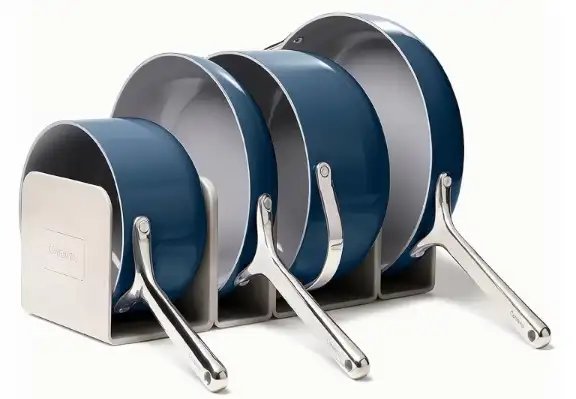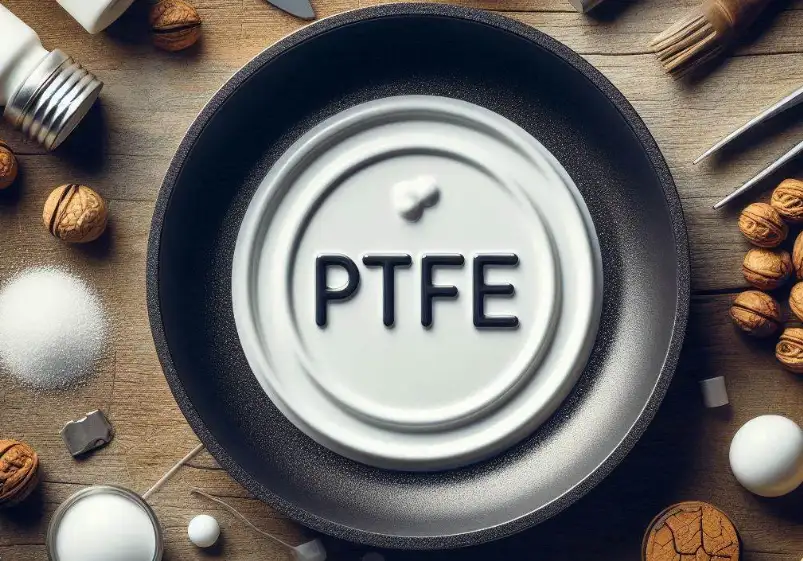When shopping for cookware, you may have come across the terms PTFE and Teflon, often used interchangeably.
But are they the same thing? The short answer is yes, PTFE and Teflon are essentially the same material, with one key difference: the name.
Understanding what these terms really mean and how they apply to your kitchen can help you make safer, more informed choices when it comes to non-stick cookware.
Let’s explore what PTFE is, what Teflon stands for, and how they impact your cooking.
What Is PTFE and Teflon?
PTFE stands for polytetrafluoroethylene, a synthetic polymer made up of carbon and fluorine atoms.
This chemical compound has extraordinary properties that make it useful in various applications, from aerospace to everyday household products.
Teflon, on the other hand, is simply the trade name for PTFE that was trademarked by the chemical company Chemours, originally owned by DuPont.
Essentially, Teflon is a brand name, while PTFE is the scientific term for the same polymer.
The History Behind Teflon
Teflon was accidentally discovered in 1938 by chemist Roy J. Plunkett while working to create a new refrigerant.
The material he found was slippery, waxy, and heat-resistant. It was later trademarked by DuPont in 1945 and introduced to the public in 1960 as a non-stick coating for frying pans and cookware.
Since then, Teflon-coated pans have become a kitchen staple.
What Makes PTFE Special?
One of the most important reasons why PTFE (Teflon) is so popular in cookware is its non-stick properties.
Here’s why it’s an essential material for cooking:
- Water-Resistant: PTFE doesn’t absorb water, making it perfect for cookware that needs to repel moisture, like frying pans and baking sheets.
- Chemical Resistance: PTFE is highly resistant to chemicals and solvents, which is why it’s used in harsh industrial environments as well.
- Low Friction: One of the lowest coefficients of friction of any solid material, PTFE allows food to slide right off the surface of your pan, reducing the need for excessive oil or butter.
- Temperature Stability: PTFE can withstand temperatures ranging from -328ºF to +500ºF, meaning it’s safe to use in a variety of cooking conditions.
- Durability: Even at low temperatures, PTFE remains flexible, which helps prevent cracking or breaking.
Check out these highly-rated Teflon/PTFE non-stick cookware options available on Aliexpress:

Why PTFE Matters in the Kitchen
For home cooks, PTFE’s non-stick feature is a game changer. It allows you to cook your favorite dishes with less oil and without worrying about food sticking to the pan.
Whether you’re cooking pancakes, scrambled eggs, or stir-frying vegetables, PTFE-coated cookware can make cleanup a breeze.
Teflon vs. PTFE: What’s in a Name?
The main difference between PTFE and Teflon is simply branding. Teflon is the name of the product owned by Chemours, while PTFE refers to the polymer in its purest form.
In terms of functionality, they are identical. Therefore, when choosing non-stick cookware, look for the material specified as PTFE or Teflon, knowing that both provide the same performance benefits.
Safe Cooking with Teflon/PTFE Cookware
When it comes to cooking with Teflon/PTFE-coated cookware, safety is a common concern.
Older non-stick cookware, especially those made with PFOA (perfluorooctanoic acid), may have posed health risks when overheated.
However, modern cookware with PTFE coatings are generally considered safe when used properly.
Here are some tips for safe cooking with Teflon/PTFE pans:
- Avoid Overheating: Do not heat your Teflon-coated cookware above 500ºF. Overheating can cause the coating to break down.
- Use Wooden or Silicone Utensils: To avoid damaging the non-stick surface, always use wooden or silicone utensils instead of metal.
- Proper Cleaning: After cooking, allow your cookware to cool before cleaning it. Avoid using harsh scrubbing pads that can scratch the surface.
Is PTFE Safe for Your Family?
Yes, PTFE-coated cookware, when used correctly, is safe for your family.
Teflon cookware has been extensively tested and, when properly cared for, remains one of the safest, most efficient non-stick options available.
It’s a great choice for busy moms looking for easy cleanup after making family meals.
Recommended Products for Safe Cooking
If you’re in the market for new non-stick cookware, check out these top-rated PTFE/Teflon options to enhance your cooking experience:
- Teflon-Coated Frying Pans: For eggs, pancakes, and stir-fries, these pans are ideal for easy food release.
- Teflon Baking Sheets: Perfect for baking cookies, roasting vegetables, or making pizza without any sticking.
- PTFE-Coated Cookware Sets: Consider a complete set for all your kitchen needs, featuring high-quality Teflon or PTFE coating for non-stick convenience.
Final Thoughts
To sum up, PTFE and Teflon refer to the same material with different names. PTFE is the scientific term, while Teflon is the trademarked name.
This versatile, non-stick polymer is widely used in cookware due to its durability, temperature stability, and resistance to chemicals.
When shopping for non-stick cookware, rest assured that you are getting a high-performance product that can make cooking easier and cleaning up even easier.
Whether you’re a seasoned chef or a busy mom, understanding the benefits and safety of PTFE/Teflon cookware will help you make the best choice for your kitchen.
And with the right products, you can enjoy hassle-free cooking for years to come.

